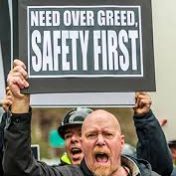
The Psychology of Stop-work authority and calling a halt to work might seem like a simple decision, However there are certain social and psychological factors can make the decision fraught with anxiety, according to Peter G. Furst, organizational and human performance consultant for Furst Group and lecturer at the University of California, Berkeley. Those factors include:
- Diffusion of responsibility. A situation in which a person is less likely to take responsibility for action or inaction when others are present.
- The bystander effect. A phenomenon in which people are less likely to offer help when others are present.
- Pluralistic ignorance. A situation in which the majority of workers internally reject a norm, but incorrectly assume most others accept it, so they go along with it.
In a 2015 International Risk Management Institute article, Furst further detailed what can cause workers to hesitate when they see a potentially dangerous situation or circumstance:
- The worker doesn’t consider a situation so hazardous that it presents a high likelihood of harm or an impending action that will lead to harm.
- The worker may assume that he or she doesn’t have the authority to get involved.
- If other workers in the area aren’t taking any action, the observer may not either, rationalizing that the situation doesn’t call for it.
- The worker might assume that the others may know something that he or she doesn’t and so takes no action.
- A worker might be afraid of alienating a co-worker by calling attention to an unsafe practice or situation.
Although some reasons for stopping work may be obvious, such as someone working under a load being transported or the absence of proper personal protective equipment, others – such as a lack of confidence in a skill or confusion regarding the instructions for the task – may be less noticeable or felt only by one worker.
“The message has always been, ‘When in doubt, stop and review,’” Gentry said. “Additionally, clients that are unfamiliar with the large number of risk opportunities on building projects can become impatient with work stoppages and/or delays. As Safety Practitioners we do our best to educate our clients before, during and after as to why we might have initiated an SWA.”
SWA policies should cover everyone on a job-site – company employees, contractors, subcontractors and visitors. Processes of an SWA action vary, but the general framework is the stopping of the work, a discussion of the reason, notification of a supervisor, corrective action of the issue and resumption of the work.
“Many organizations and employees may believe that it takes a lot of time to stop, notify, investigate and correct on each stop-work (case),” said Todd Forry, health and safety manager for Laramie, WY-based Trihydro Corp. – an engineering and environmental solutions company – and president of the Wyoming Oil & Gas Industry Safety Alliance. “However, depending on the circumstance, hazard abatement can be an easy fix – picking up or moving a tripping hazard or coaching a co-worker on their unsafe activities.”
Jack Hinton is chief health, safety and environment officer at Baker Hughes, an oil and natural gas company based in Houston. Hinton said a 2017 integration of safety processes in the field resulted in a large uptick in SWA use. The attention to communication paid off.
“In just one year, our employees stopped work on customer well sites due to a process safety risk 50 times – an increase of 84 percent from the prior year,” he said. “The recognition of process safety risks and the courage shown by our front-line employees are key behaviors we encourage and expect, as these are critically important to avoid catastrophic incidents.”
Clear communication of SWA policies is crucial each SWA must have a support system with guidance and corrective actions or a “Near Miss Reporting System”. In California employers has a legal obligation to provide and maintain a safe and healthful workplace for employees, according to the California Occupational Safety and Health Act of 1973. As of 1991, a written, effective injury and illness prevention program is required for every California Employer and creating a “Near Miss Reporting System” is one of the first steps.
Petersen said two of the most important aspects of an SWA policy are clarity of what constitutes a hazard worthy of stopping work and the assurance of no negative consequences for doing so – from the company or co-workers. Thus a “No Blame” Safety Strategy is the most effective option. Because no one wants to be blamed for a work-related injury or illness. The No Blame Safety Strategy Liberates EHS professionals, freeing employees from employer reprisal. “Now we’re talking Safety”.
“It doesn’t matter if it’s a 2-person job or a 200-person job, if there’s something workers are not comfortable with, whether it’s (from) a safety standpoint or an understanding of the job in general, Safety Stand downs are covered in the site specific safety orientation, on boarding of new and existing employees each person working on site has the right to stop work, and shall contact the first line supervisor.
